Barcelona finally returned to Camp Nou with plenty of new players added to the squad in the winter transfer window. Some of the reinforcements started the game and played really well in the 4-2 victory, including Dani Alves and Adama Traoré who played on the right side. Contrarily, despite beating Ronald Koeman’s Barça back in October, Diego Simeone’s Atlético Madrid could not give the same standard of performance away from home – the conceding of goals in critical moments was catastrophic.
This tactical analysis explains how Xavi integrated his new players into the positional structure and tactics – these were the keys to solving the block of Atlético Madrid and we shall investigate.
Lineups
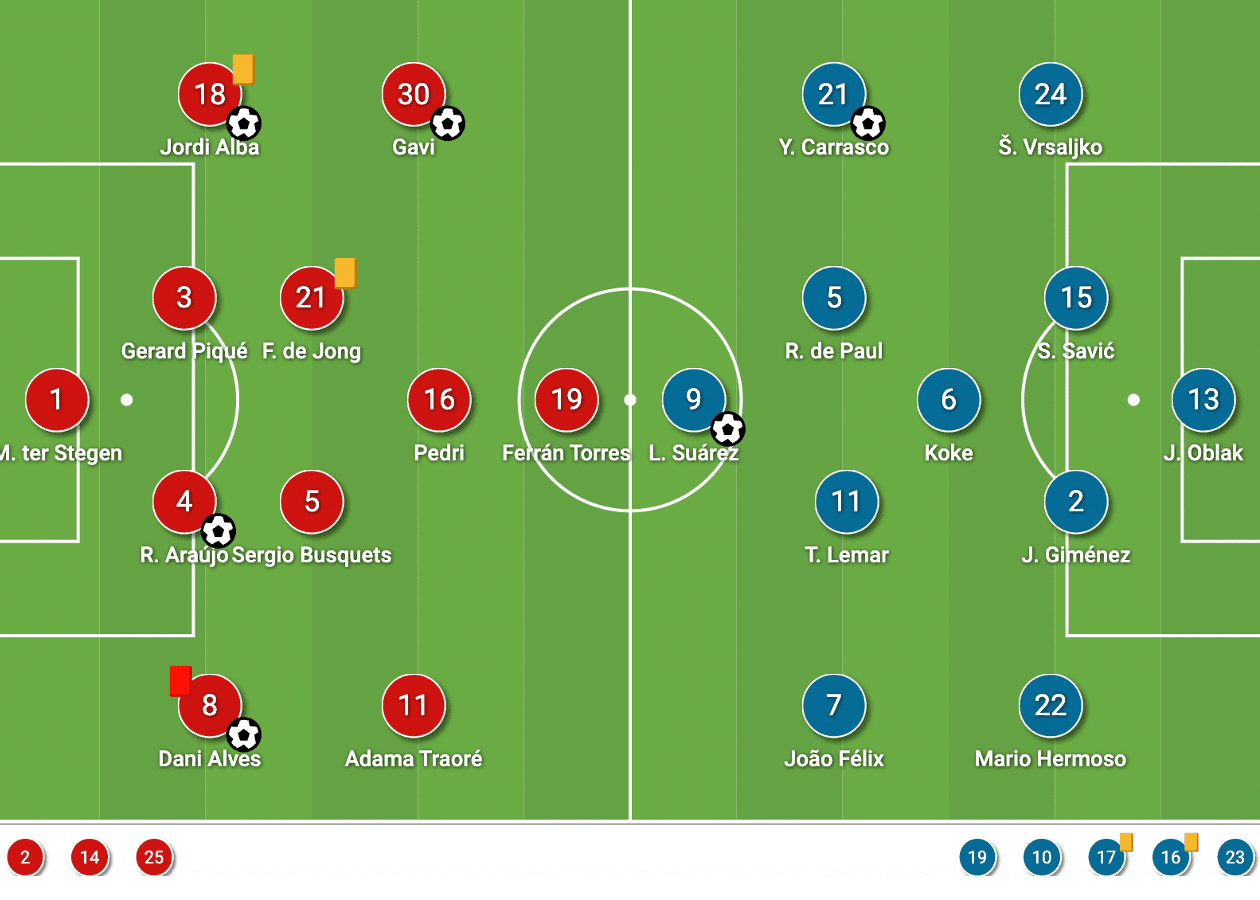
Barcelona played with a back four system but shifted flexibly between different attacking approaches. New arrivals in the winter such as Alves, Traoré, and Ferrán Torres started while Pierre-Emerick Aubameyang started on the bench.
Atlético started in a 4-1-4-1 with Yannick Carrasco and João Félix on the flanks, but they later switched the formation to handle the attacks of the opponents. Šime Vrsaljko and Mario Hermoso were the full-backs and they suffered a lot in this game.
Barça’s rotations and switches
Xavi must have learnt a lot when he was a player under Pep Guardiola, to him, formations were just numbers. The tactics of Manchester City and this Barcelona also shared some similarities because the players rotated and moved to create better attacking conditions. The first section of the analysis will dissect how Xavi’s Barça attacked from the flanks.
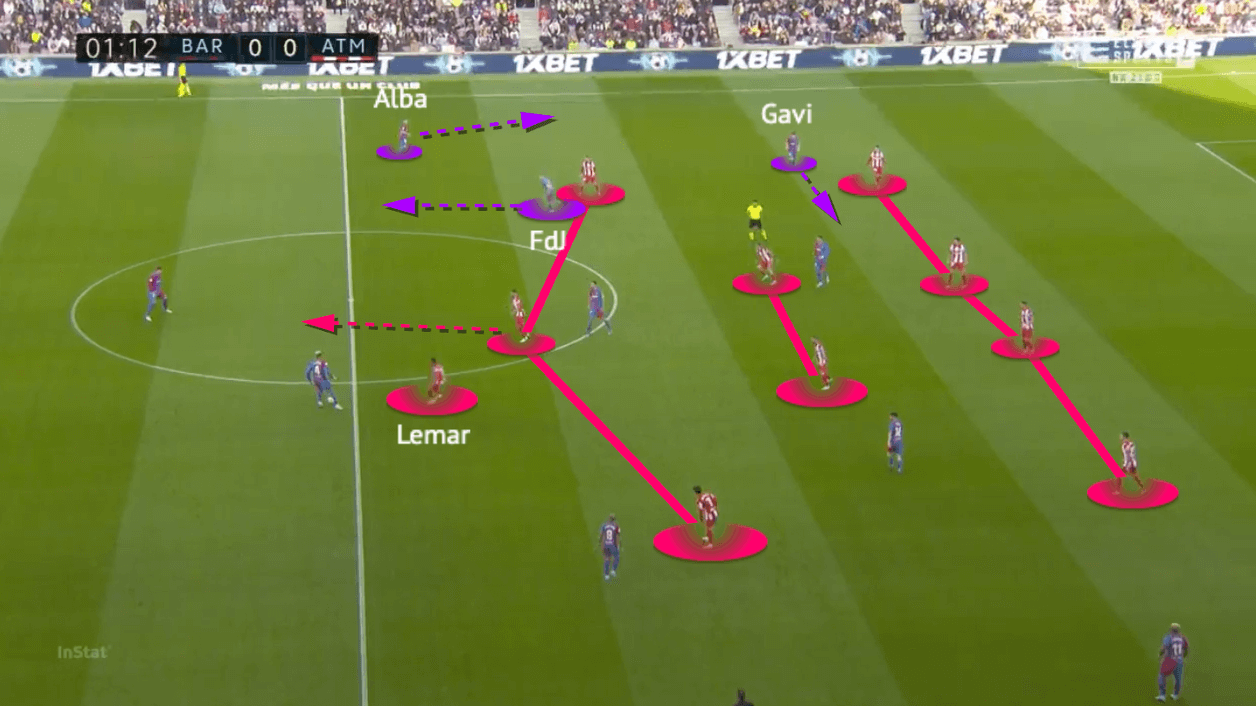
Before the game, Xavi already knew they would face a compact block because that was the strength of Simeone’s Atlético. To break the block, he designed his team to use the left side as the stronger side, with more numbers, movements, players, Barcelona would try to overload and advance with combinations. Contrasting to the left side, Traoré would receive less help from the full-back on the right because he needed more open spaces to dribble take on the left-back.
Barcelona mainly had two ways to attack. In the early period, Xavi’s side needed a goal and the need became more desperate after Carrasco’s opener. They were more aggressive in possession with Gavi operating as a false-winger, constantly making inward movements to engage Vrsaljko to open the wide channel for Jordi Alba. When Alba pushed higher, Frenkie de Jong could drop from the midfield as a wide centre-back, making it a temporary back three for Barcelona. It was useful against Atlético because the opponents would first commit the 8 (Thomas Lemar) to press Ronald Araújo, then pressing Gerard Piqué when the centre-back received a lateral pass from the partner. Hence, de Jong’s presence in the first line could make it a 3v2 for ball progression in the half-spaces, as shown in the above image.
In this game, Sergio Busquets demonstrated the qualities required to be Xavi’s holding midfielder. This position does not need to run a lot, but rather be a calm reader of the game and use his position to dictate plays. We would investigate more later.
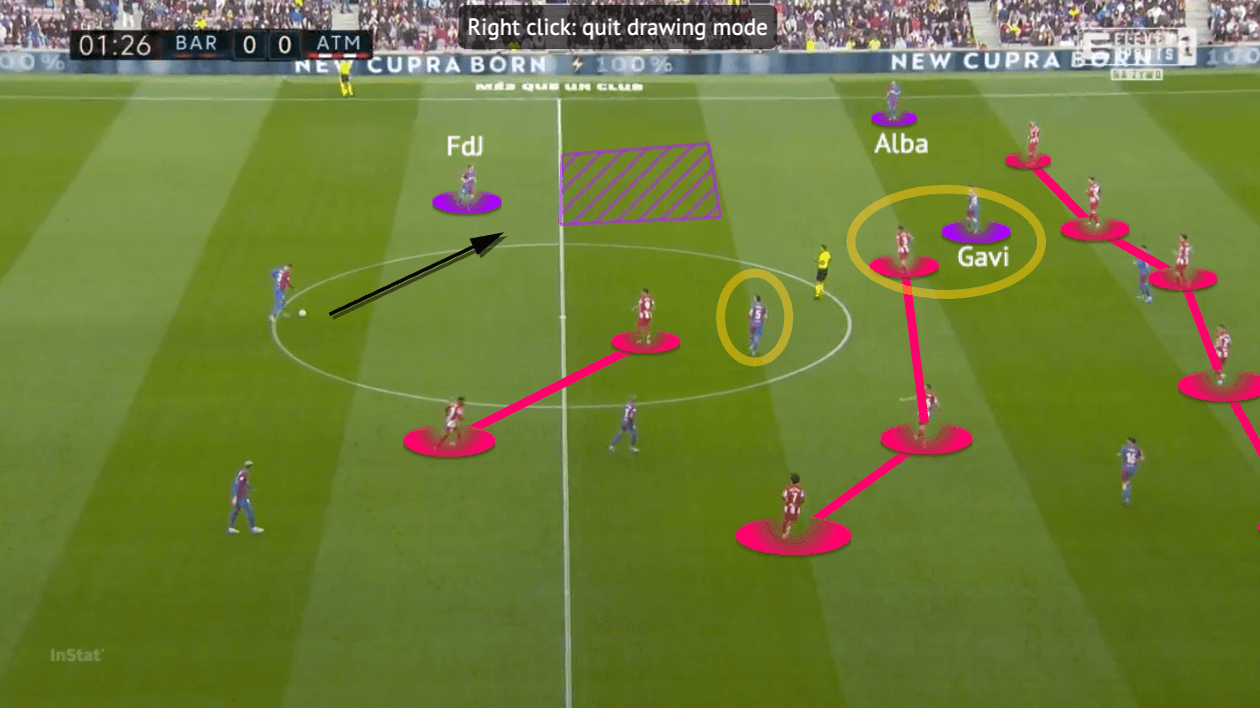
Alternatively, the movement of Gavi can be more than engaging the right-back. When he came infield, that was also a behaviour to manipulate the second line to ease the press. At times Atlético’s winger dropped into wider areas to cover the full-backs, making it a back five to allow better horizontal coverage in the block. This was a more frequent scenario to cope with Traoré’s threat after Barça took the lead, but that was also seen at the beginning of the game. The deep runs from Alba was a threat in the first period of the game, when he ran past the defender, he created chaos and miscommunications on the Atlético right-back and right-winger as the opponents were also dealing with Gavi’s movement simultaneously.
Again, de Jong dropped to receive as the left centre-back in the above screenshot, but what is important are how to create good conditions for the Dutchman. It was also a 3v2 numerical superiority in the first line as explained above, they bypassed Lemar and Suárez easily. Meanwhile, Suárez was also fixed by Busquets, as the holding midfielder just only had to stay centrally to keep the marker in that central corridor, so de Jong would not confront pressure laterally when he entered the purple space.
Apart from Busquets, Gavi’s inside positioning manipulated the second line, so Rodrigo de Paul was occupied, and he would not step up to confront de Jong early. With Alba also holding the width to push the winger down, de Jong had a lot of room to pass the ball forward in this structure. Barcelona advanced the ball comfortably in the early period thanks to these positional strategies.
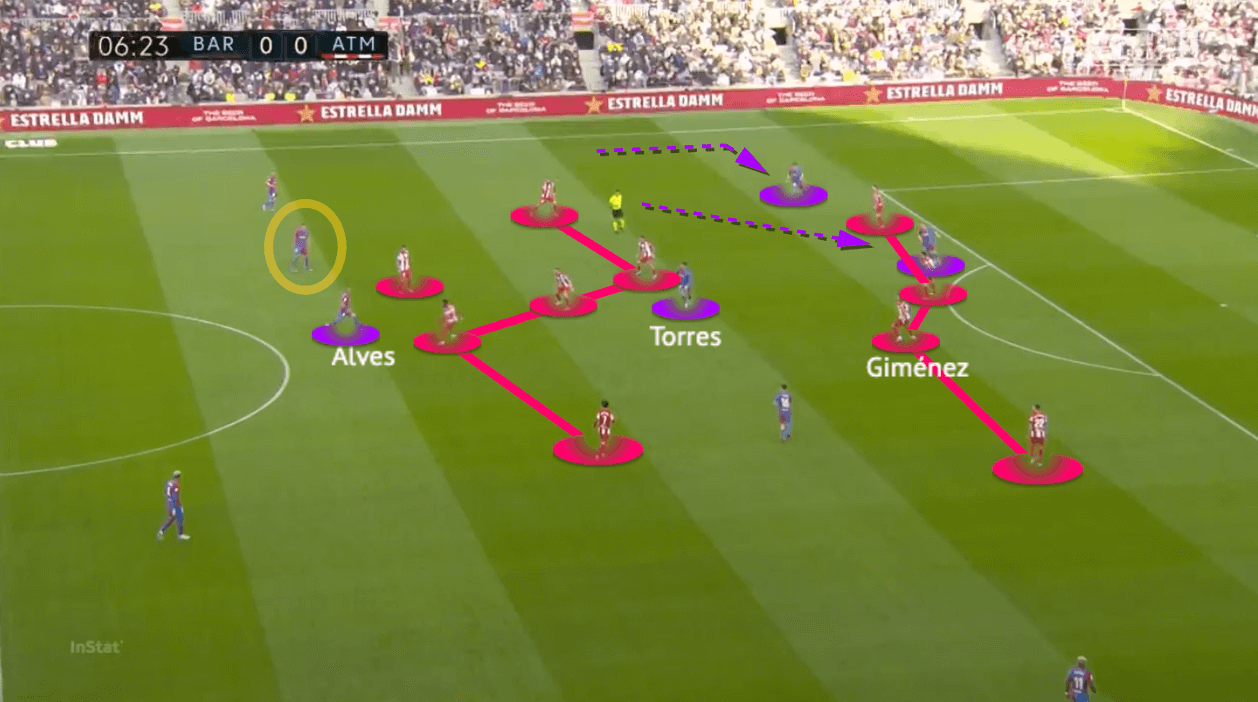
Apart from Busquets, the midfield of Barcelona also consisted of Alves, who played as the inverted right-back or you can call that as a hybrid player. The Brazilian might no longer possess the pace to make forward runs on the right corridor, but his passing vision and techniques were valuable to Barça’s ball progression.
In the first 20 mins, Barcelona injected so many runs to attack depth on the left side, so they always pushed the last line of Atlético backwards and created more spaces behind the midfield. The above image shows how Alves was able to pass the ball without the pressing of Suárez since Busquets (yellow circle) occupied his former teammate in the left half-space. Also, after the runs made by Gavi and Alba on the left side, they pushed Atlético into an asymmetrical block with spaces appearing between the lines. In this game, Torres also dropped to receive in the centre, especially when the 8s of Barcelona drifted wider to unmask the passing lane, that was a signal to trigger the movement.
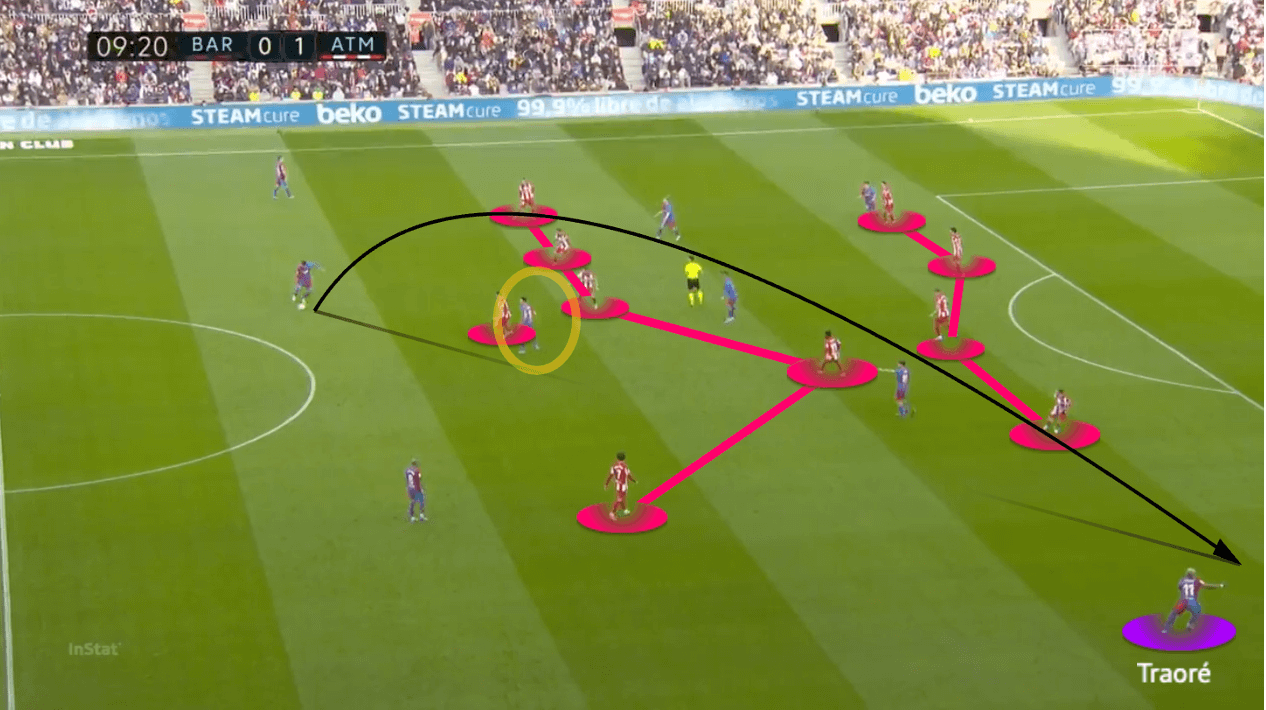
Everything Barcelona did on the left side actually might be a decoy, they also had the awareness of playing left to go right. That means they used the numerical overload and combinations on the left as a bait to drag the opponents to one side, then allowing Traoré to exploit the left-back with a big switch into the open spaces. Hermoso had a very difficult day when he had to defend Traoré alone.
The above example shows Busquets occupying Suárez again, so the Uruguayan striker was not jumping out to press Alves. Consequently, Alves could play it long into spaces for Traoré on the far right. The former Wolves player contributed five dribbles and completed four of them, also winning four offensive duels from seven, which showed his physical prowess had injected a lot of penetration for Xavi’s side. That was something the other players could not provide in the current squad.
Going through the centre
Apart from advancing from the flanks, Barcelona also tried to play in the centre at times although this is less smooth. This brought out the other structure used by Barcelona in this game, we did not specifically use a section to explain the alternative positional structure, but after 2-1 Xavi’s side were more conservative to expose fewer spaces behind the full-backs in transitions.
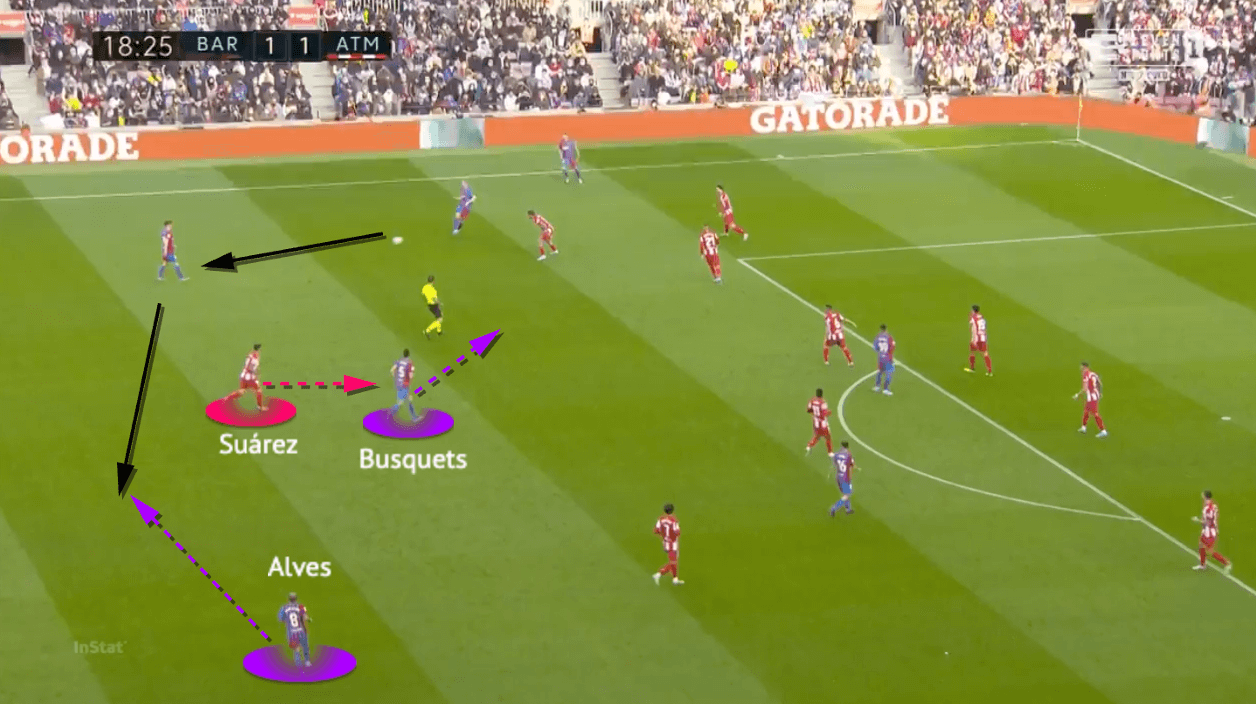
Firstly, we had to appreciate the contributions of Busquets to help Barcelona dictate in the midfield. As mentioned, the holding midfielder of Xavi might not need to run around, he just had to move in an optimal moment to manipulate the marker, or sometimes even not moving can be a solution for the team.
In the above example, Barcelona were going from the left to right which is based on the principle we explained. Given the deep and compact block of Atlético was deployed in the last third, Barça needed to stretch them vertically with passes. Here, again, Alves came inside as another 6 for the team, using the spaces vacated by Busquets’s movements. Since Félix was rather lax against the ball, Alves could choose to circulate or quickly find Traoré on the right side.
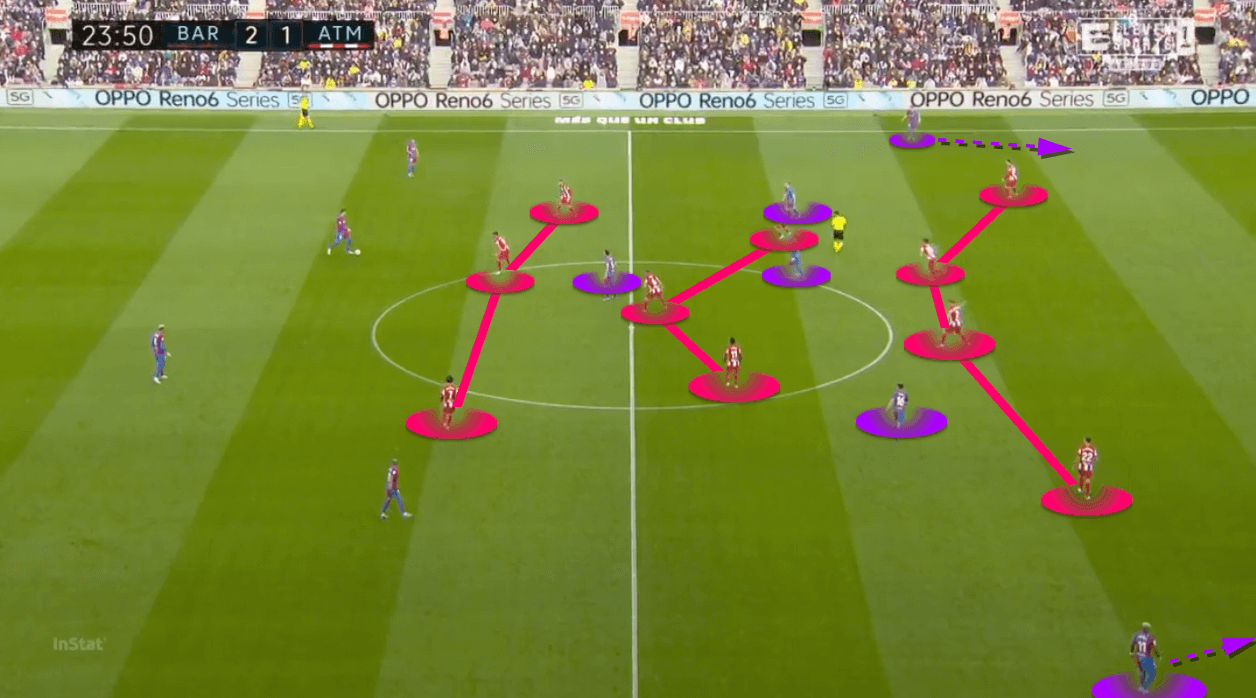
Barcelona wanted to have more control as they came back from behind at the 21st min, so the full-backs were deeper to restrict the spaces available for Atlético to counter in transitions. The shape was more like a 4-1 or a 2-3 in the centre with Alba staying deep also, holding minimum width to play outside of the Atlético first line. But Xavi would never drop the idea of having the constant occupation of offensive heights and maximum widths – the principle of plays is non-negotiable. Hence, Gavi and Traoré stayed high and wide as a pair of conventional wingers, kept searching for the offensive depth to fix the last line as illustrated above.
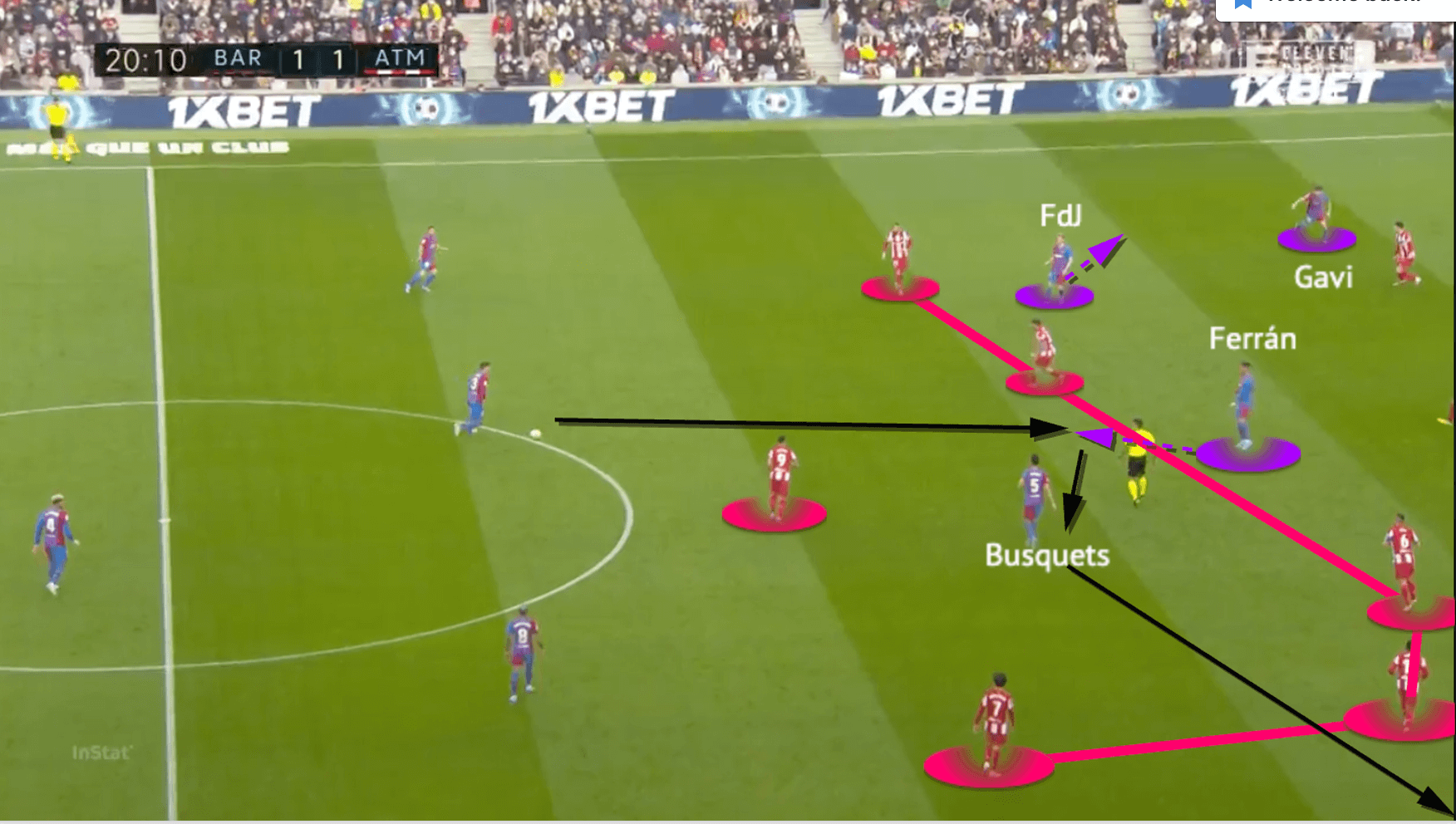
When Torres dropped, he could be an additional option in the midfield for Barcelona’s ball progression in the centre. However, he should use the third man more to evade pressure because turning in the centre was not his thing. When the likes of Stefan Savić and José Giménez came out to press, the former Manchester City attacker might lose the ball.
The above example showed one of the Barça routes to play in the centre. With Gavi’s constant engagement on the right-back, Atlético must react to de Jong’s run by the midfielder moving wider. When the Barcelona 8 drifted outward, the passing lane in the centre enlarged and they could play inside the block, then using Busquets as the third man to find Traoré out wide. Pedri would also make the same outside movement from the right half-space for Torres as well.
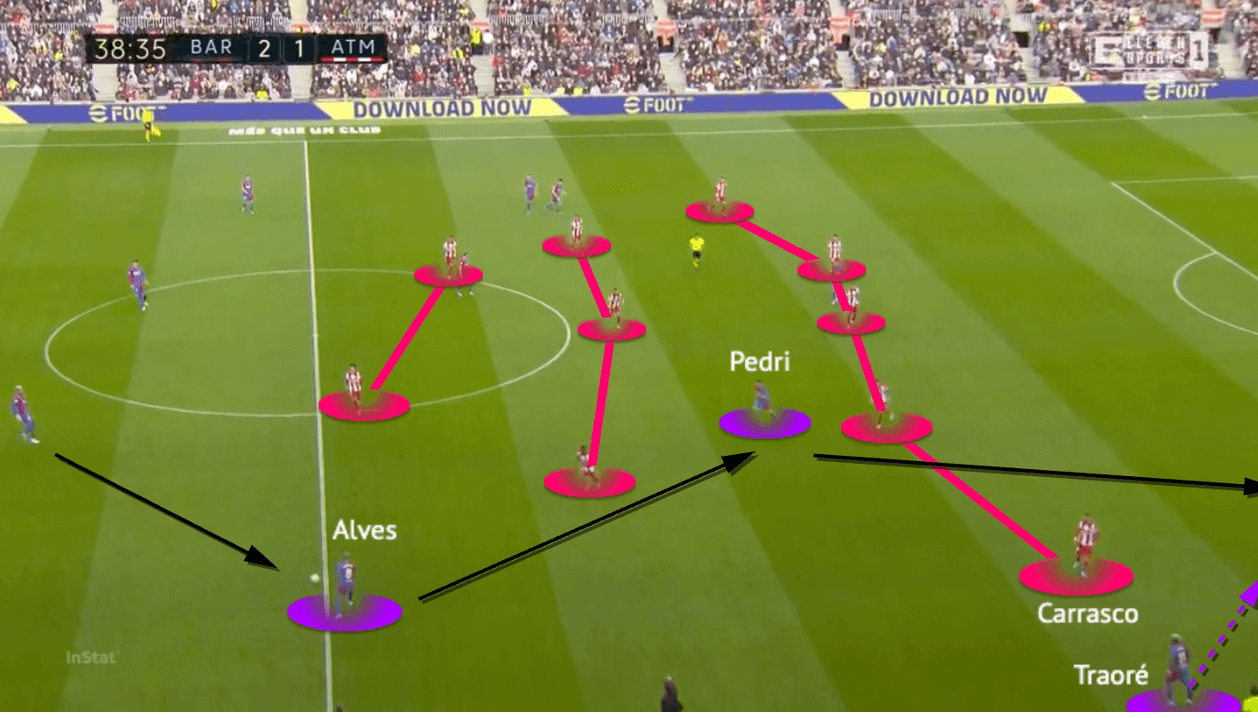
Atlético later switched the formation to more like a 4-4-2 on paper, and a 5-3-2 out of possession. Carrasco was moved to the left side to defend the wide spaces as a wing-back, allowing his team to close one side with better horizontal compactness in the last line. That was a temporary solution as Carrasco’s presence lightened the burden of Hermoso, but the problem was the half-spaces occupation of Barcelona 8s.
The above example shows Barça advancing the ball with minimum width in the construction phase, as Alves was just outside of the formation to receive and pass. Then, Pedri’s position would be key, against the back five, the 8 shall draw the wide centre-back out to create isolations on wing-backs. In the second half, we were seeing these elements more often.
Atlético must be more aggressive
As Simeone said, the guests were not aggressive enough at Camp Nou, increasing the intensity must be one of the topics to address during the break but the timing Atlético conceded the goals were terrible. When Alves scored at the 49th min, Barcelona killed the game already. But there were also more noticeable tactics in the second half which we would explain in this section.
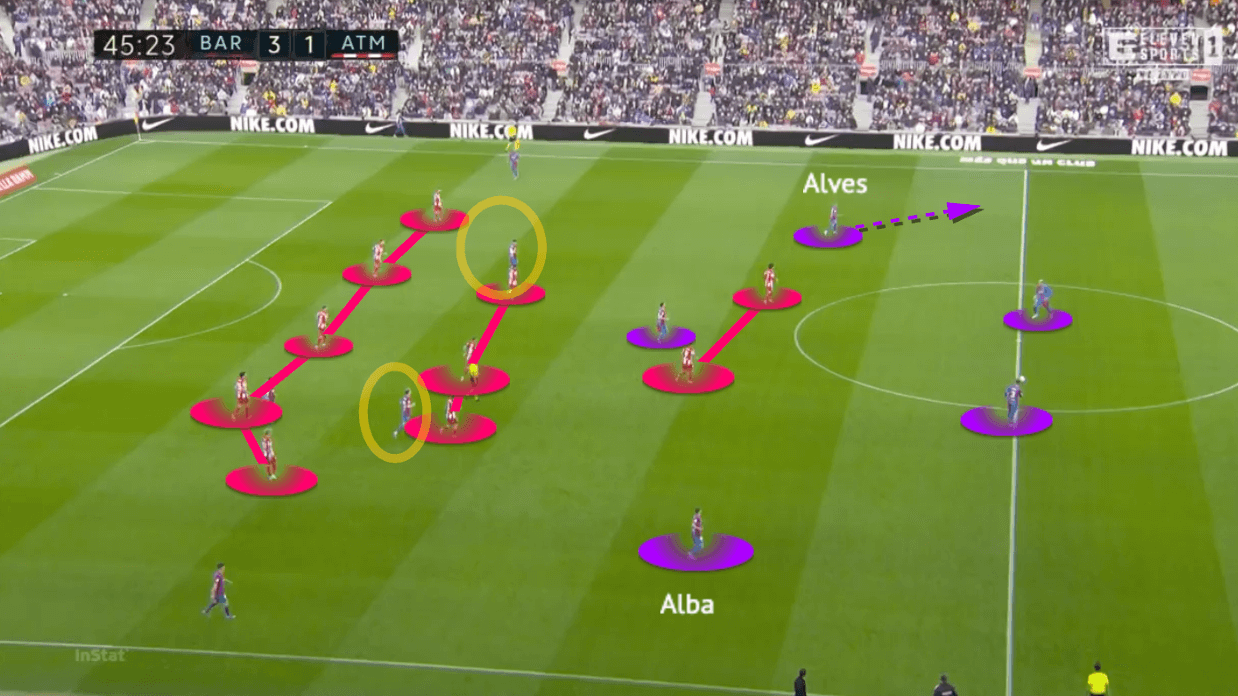
Atlético defended in a 5-3-2 block more often as Carrasco was often deep to keep track of Traoré in the wide spaces. Simeone expected his defenders to be more aggressive to close spaces in front and so the team could press higher, and the wing-backs should also close the opposition full-backs vertically if the Atlético midfielders could not jump out to press diagonally.
For Barcelona, they had a clearer 4-1-2-3 approach that was explained above. The full-backs were holding minimum width to play outside of the formation, or we can interpret that as a 2-3 with a 3v2 numerical overload against the first line of Atlético. To create more spaces for construction, the 8s are constantly occupying the half-spaces to pull the wide centre-back out, while also manipulating the Atlético midfielders at the same time.
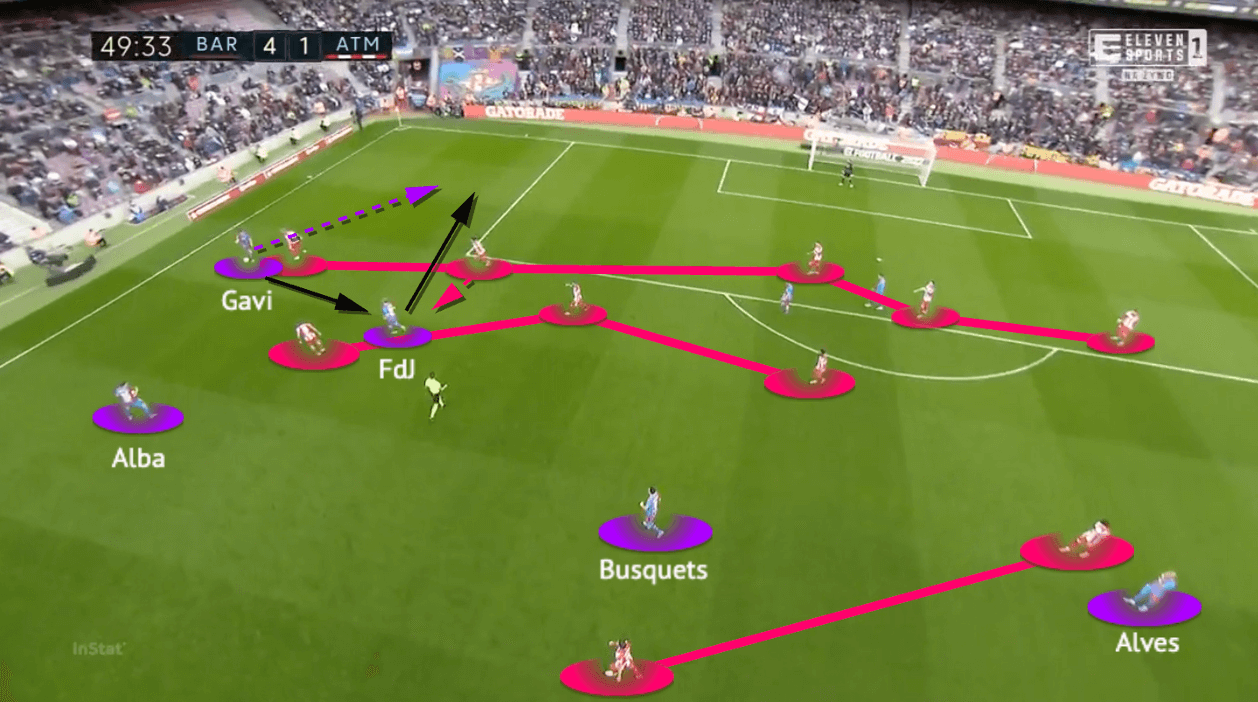
These tactics contributed to the Alves goal. We took the screenshot from a higher angle to show the function of this structure. It was de Jong’s half-space occupation to pull Savić out, creating spaces behind for Gavi to exploit in the one-two move. That was Atlético’s problem in the entire day as they was not aggressive to close spaces when stepping out, then they suffered because the opponents could go back and use the spaces behind.
In Xavi’s football, attacking and defending are not separate elements. Instead, they are correlated, and Barcelona were also defending when they were attacking, that was about how they deployed the rest defence structure to handle the offensive transitions. This was the reason to have a pair of deeper full-backs and hold minimum width as shown above, Alves was in the inside so they had three men in the first line, capturing the ball if it was played into the centre in the transitions. But that does not mean the players should be waiting, when the ball was going forward, they also had the freedom to attack and that was how Alves scored with a run from deeper areas.
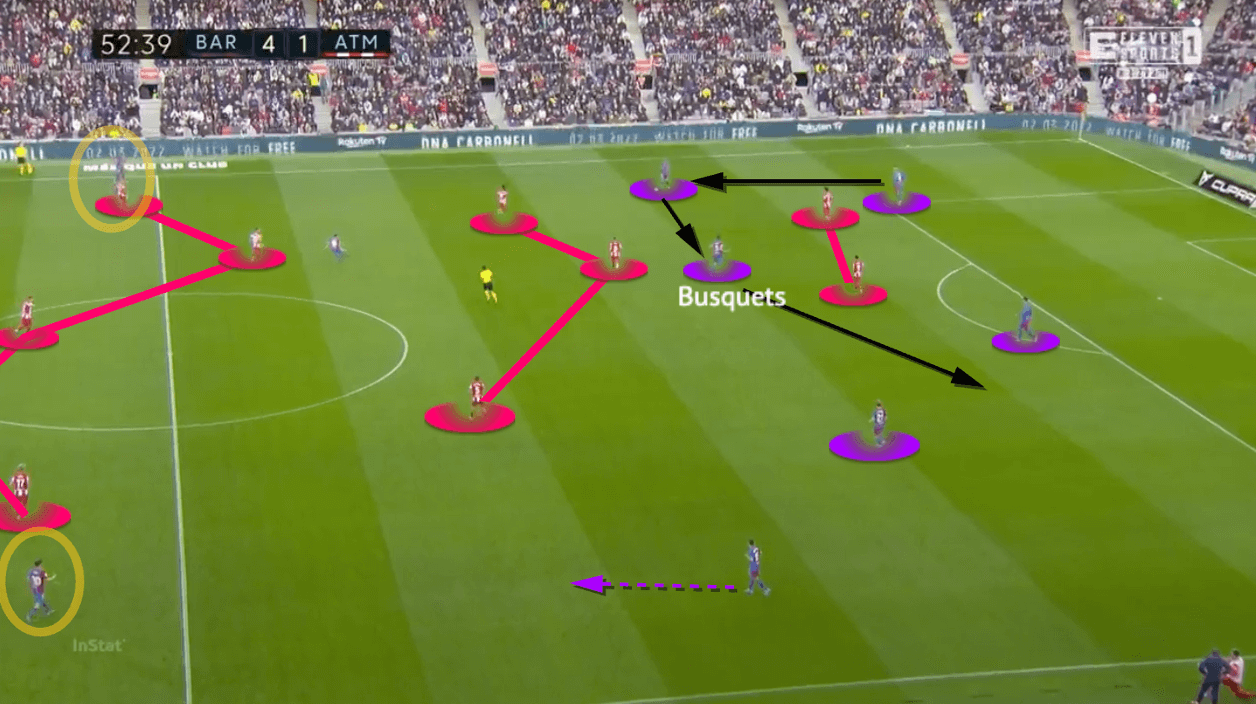
Since Atlético became more aggressive in the press, the two-man first line often engaged the centre-back as Suárez no longer had to man-mark Busquets. But that also became a problem as Barcelona were clever enough to use the holding midfielder to solve the press. In the above example, they simply used a square pass to reach Busquets, who was free as Suárez was pressing the centre-back in his initial move.
Let’s not forget Xavi’s principles to have constant occupations of heights and widths in the attack. In the entire construction process, the least thing Traoré and Gavi should do was to drop deep because they must fix the last line as circled.
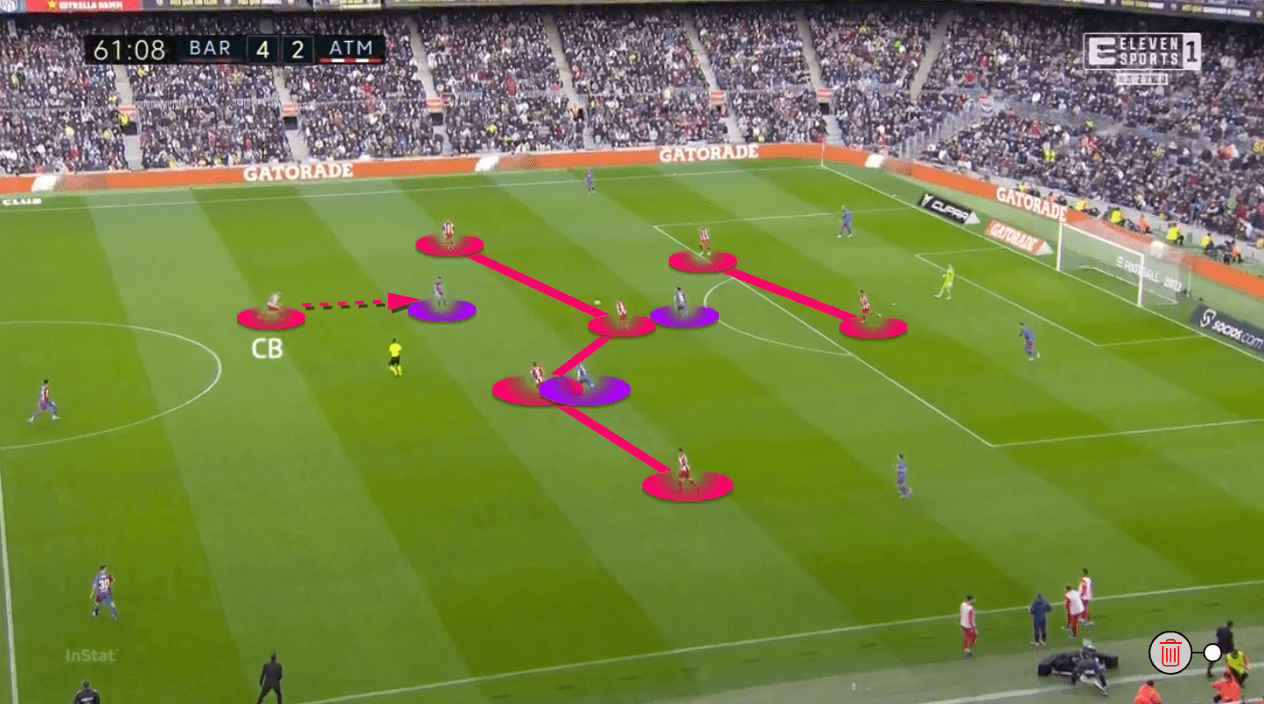
One thing Atlético did well was to press higher after they scored the second goal. In the against goal-kicks, Barcelona’s three-man midfield always gave them an additional “+1” advantage in the build-up, and Pedri was always moving behind of the Atlético midfield (they pressed in a 4-4-2). Simeone counter-acted by using that as a trap, instructing Giménez to press from behind and Pedri lost the ball the centre for a few times, but Atlético were unable to capitalize in these transition occasions and they were not converting the chances after Alves’ red card either.
Barça’s pressing is also important
In possession, Barcelona played better than the first clash because the players had more discipline in their positions. While out of possession, they were also better with a more intense press. The biggest difference came at the engagement line as the front players carried more intensity. The likes of Torres and Traoré were hardworking and were willing to cover larger distances to close the ball carrier down, forcing the opponents to have less time playing the ball forward. Even Busquets was very aggressive when he jumped out to press high, so the last line of Barça received less pressure.
But there were also room for improvements. For example, they conceded too many set-plays opportunities and even Xavi himself admitted that was an aspect to learn from the opponents. Also, they had to defend spaces behind the last line better, while the outside space of Alves could be a weak spot without the help of the right-winger.
Conclusion
Although this was a good and improved performance from Barcelona, and also a result desperately Xavi needed to instore confidence, scoring four goals might be slightly exaggerated because the xG of Barça was 1.31 only. Anyway, the win was very important and finally Barcelona were back to the top four. Playing the football positionally was never easy and there would be more problems arising, we were so keen to see the solutions of Xavi and how could he transform his side given some players had clear weaknesses.
Simeone believed Barcelona were the more clinical side as they buried three chances out of four in the first half, while his Atlético could only convert one from four in the same time span. They had already conceded 12 goals from their last five games and that was not a good sign; with only two wins in their last eight La Liga games, they had to bounce back as soon as possible to guarantee a UEFA Champions League spot for 2022/23.





Comments